Details
Klipsch THE NINES aktyvios garso kolonėlės (pora) su HDMI ARC, Bluetooth Phono, Galia: 240 W / RMS, dažnių juosta: 34Hz - 25kHz | Nemokamas Pristatymas
Klasikinio dizaino garso kolonėlių pora atitinkanti visus Klipsch garsui būdingus standartus. Tai kolonėlės, kurios nepaliks abejingų!
Didelio galingumo aktyvios lentyninės garso kolonėlės, norintiems paprasto spandimo, tačiau kokybiško ir kambarį užpildančio garso.
Plačios pajungimo galimybės, sodrus žemo dažnio atkūrimas dėka 8" garsiakalbio, bei ruporinis aukštų dažnių garsiakalbis leis mėgautis muzika bei filmais be jokio vargo.
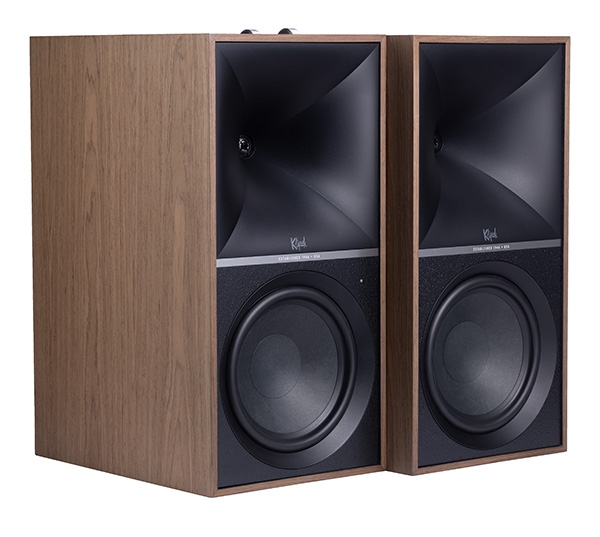
That quest may be ongoing and never-ending, because our tastes and preferences evolve over time, money comes and goes, and we're simply never satisfied. And even if we are, eventually, we're audiophiles, and the industry always offers something interesting and new, or something old that's new again.
My time with a pair of Klipsch The Nines speaker-gadgets (footnote 1) reminded me of the exciting, youthful bloom of my first serious sound system: a Technics SL-D2 turntable with Audio-Technica cartridge, a Philips 45Wpc receiver, and New Advent Loudspeakers. That collection of early-1980s components opened my ears to the endless variety and flavors of recorded music. It stayed with me through college and into early adulthood. I spent thousands of hours with that system, exploring artists and genres, learning music history, forming and refining my own aesthetic.
That system served me well. In middle age, I've had to spend a lot more money and effort to build a system that tickles my sonic bones as intensely as that one did. And then The Nines came along and—well, it's too soon to say what I thought about The Nines, so for now let's just leave it at that.
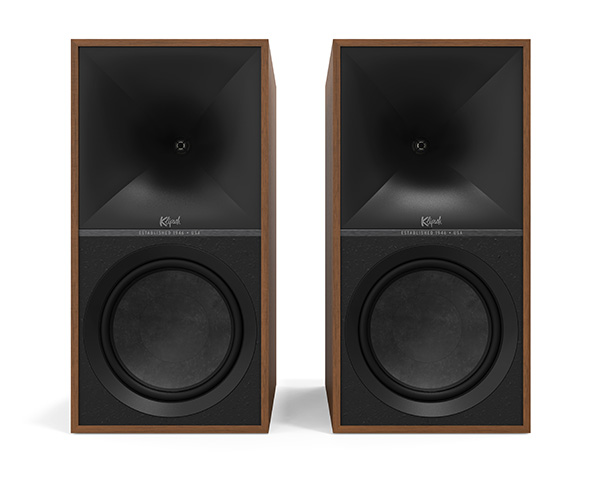
Voice, heart, and guts
The Nines are part of Klipsch's "Heritage Inspired Power Series," which also includes the Fives and Sevens, similar but smaller speaker-gadget systems. The Nines are the fullest-range and largest speakers in the series. You can buy them directly from Klipsch or from a Klipsch dealer. You can also buy matching 24" stands.
I spent about two months with a pair, in the Walnut finish with off-white fabric grilles, on the matching black metal stands. They're also available in black with black grilles.
The Nines is a two-way, bass-reflex speaker system with a rear-ported, 8" "high-excursion fiber-composite cone woofer" and a 1" "LTS vented tweeter with Tractrix horn." The crossover between the two drivers is at 1.6kHz, which equates to about G#6, nearly four octaves above Middle C. The veneer boxes are a very manageable 19" high, 9.5" wide, and about 13.5" deep, and each weighs less than 30lb. However modest in physical size, they put out quite a bit of well-sorted sound.
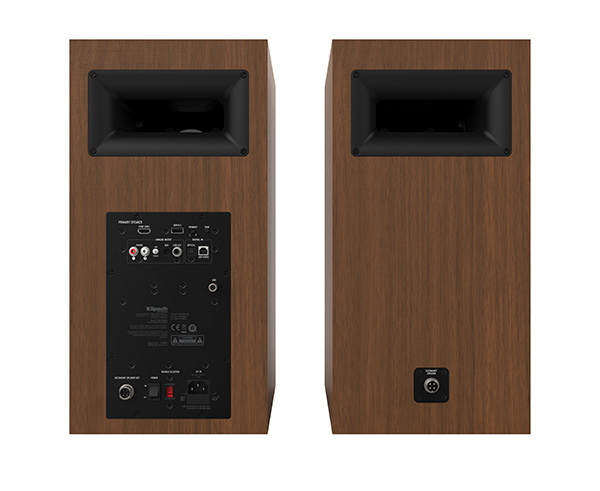
The heart of the system, or maybe its nervous system, is built into the back of the Primary speaker unit (on which there is a switch to select its placement as either left or right): electronic module providing input switching, D/A conversion, and class-D amplification. The speakers are connected via a 4-pin, 4m umbilical cable; a 2m extension cable is included in the box. All input connections, and the mono, single-ended RCA subwoofer output, are on the rear of the primary speaker. Wired digital connection—PCM input up to 24/192—is via HDMI-ARC (audio-only HDMI, common on modern flatscreen TVs), S/PDIF optical (TosLink), and USB2 Type B. Wireless connectivity is also provided, via Bluetooth 5.0 and the SBC, AAC, aptX, and aptX-HD audio codecs. There are two analog inputs: one L/R pair on RCA and a 1/8" (3.5mm) stereo miniplug. The RCA inputs are switchable, for a line-level source or a turntable, which connects with the built-in MM phono preamp. (There is also a phono-grounding post.)
Matt Spitznagle, Klipsch's VP for technology and innovation, described the system this way. "We use class-D amplifiers selected for low distortion and excellent noisefloor. Our high-efficiency acoustics demand high performance from the amplifiers. ... In this design, we use a separate DAC that drives analog-input class-D amplifiers. The DAC and amplifier ICs are all from Texas Instruments." He added, "Each driver in the system has its own amplifier channel. All audio processing is performed in DSP. This greatly mproves the precision of the crossovers and equalization and therefore the overall consistency of the sound. The DSP is running at a 96kHz sampling rate for additional high-frequency extension.
"All the electronics are located on the rear of the primary speaker. The umbilical cable carries two pairs of conductors: one for the [high-frequency] section and one for the [low-frequency] section of the secondary speaker. We used a proprietary connector type to avoid any chance that the system is miswired and to make the system easier to set up."
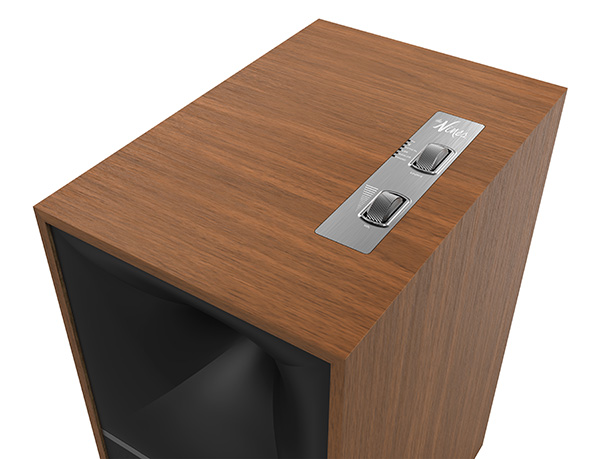
A control app, Klipsch Connect, is available for Apple and Google devices. It works via Bluetooth. The app includes a three-band "virtual" equalizer with bass, mid, and treble tone controls, +6/–10 dB each for each band, with presets for "flat," "vocal" (enhanced midrange and reduced bass), "bass," "rock" (with bass and treble increased 3dB and midrange down 1dB), "flat," and "custom" (which means set 'em however you like). There is a "Dynamic Bass" on/off button, which engages a DSP-based loudness curve that varies with volume level. The app allows input switching, and there's a Settings menu. In Settings, you can select one of three "Speaker Placement" options, which engage DSP to reduce the low bass output when the speaker is placed in a corner or against a wall. When a subwoofer is plugged in, a subwoofer-output level control is available. The system also comes with a small plastic remote.
"The goal was for a neutral and accurate sound out of the box with the possibility for the customer to customize the sound to their taste using the app," Chris Perrins, VP of acoustic engineering at Klipsch parent Premium Audio Company, told me.
A gadget for ... what?
Klipsch markets The Nines as equally at home in an audio-only system or as full-range TV speakers (footnote 2). The audio source may be streaming-centric modern—for instance with a laptop or Roon-connected streaming appliance at its heart, connecting digitally, or a Bluetooth connection from a phone or tablet. (Bluetooth's disadvantages—reduced resolution and lossy transmission—are sometimes trumped by convenience.) But don't forget about those two analog inputs: A hi-fi system built around The Nines can expand into vinyl or receive analog sound from an older TV without a TosLink or HDMI-ARC output. Or a CD player can be connected, via TosLink or one of the analog inputs, or even a radio tuner.
The first thing I did when I got The Nines unpacked, placed on their metal stands, and connected was connect my iPhone by Bluetooth. It was quick and easy. "Klipsch The Nines" showed up as a connection option, and pairing worked without a hitch. I streamed hours of Qobuz playlists including two created by Klipsch (footnote 3).
This was in my small "TV room" space, next to my studio. My purpose was to break in the speakers and to get a general idea of their sound. The speakers can be spread quite far apart in relation to the listening seat without creating a hole in the soundstage. The soundstage they created was also rather tall. The sweet spot was wide, so two people could sit on a sofa, not too far back, and both get large, well-balanced sound.
I immediately noticed the bass, which was ample but not overhyped. There's not enough to load up a big room, and it can get wooly when music with heavy bass is pushed to high SPLs—that's why there's a subwoofer output—but they provide good low-frequency extension and pack quite a punch. Break-in? Low-frequency detail and extension improved a little bit after several days of music, including my "Burn in METAL HELL" playlist (footnote 4).
Next, I moved The Nines into position as TV speakers, a couple of feet to either side of my "vintage" Sony WEGA, from the last generation of CRT-based televisions. It's old enough to have multiple NTSC analog video inputs and a now-useless off-air tuner. It's new enough to have one HDMI input and a slot for a still-useful CableCARD tuner. This TV doesn't output TosLink or HDMI-ARC, so an analog connection was mandatory. Unfortunately, the TV's RCA outputs delivered very audible hum along with the audio. An old Jensen Iso-Max in-line ground-loop filter solved the problem.
Turns out, The Nines are great TV speakers as long as the audio they are fed is half-decent. It also turns out a lot of streaming TV audio is less than half-decent. For broadcast TV, the audio from Comcast cable's Xfinity app on my Roku box sounds much worse (often distorted, often highly compressed, often with audible digital artifacts from lossy transmission) than audio from the CableCARD tuner connected directly to the cable system's coaxial 75 ohm line. The audio from the Roku for MAX (formerly HBO Max, now combined with the former Discovery+), Disney+, and Paramount+ apps was good to excellent. That big sweet spot was a big advantage for TV viewing with more than one viewer at a time.
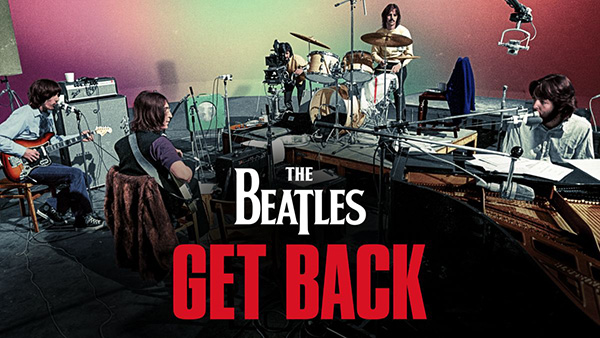
My wife and I enjoyed streaming The Beatles Get Back documentary on Disney+. We could easily hear the digital artifacts in some of the dialog recovered by Peter Jackson's "demixing" technology. Most of the music, though, sounded great. We also watched two of my favorite "rock-u-mentaries" on MAX: the Rolling Stones' Gimme Shelter and Monterey Pop. In both cases, the well-restored stereo sound shined and complemented the excellent picture restorations. I got a kick out of watching NFL football with the big sound, the spectacle enhanced by extra-wide stereo crowd noise and sometimes more on-field trash-talk cussing than the network censors could silence. It was interesting to compare the different sound-mixing approaches taken by each network. (CBS Sports does it best; Amazon Prime does it worst.)
Music ... in HD
It was time to settle in for some serious music listening. I connected my laptop to the USB socket. Windows 10 had no problem sorting out USB2 audio protocols with The Nines, no driver installation required. I streamed Qobuz from the PC app and played files ranging from MP3 to 24/192 from my music library mirror drive, connected to the laptop's USB3 socket.
Specifikacijos:
- Aktyvios bevielės kolonėlės
- Bluetooth sąsaja
- Korekcinis stiprintuvas plokštelių grotuvui prijungti
- HDMI ARC jungtis
- Natūralaus medžio apdaila
- Skaitmens analogo (D/A) keitiklis su USB (B) bei optiniu (TOSLINK) įėjimais išoriniams įrenginiams prijungti
- Aukštų dažnių garsiakalbis su patentuota Klipsch Tractrix® ruporo technologija
- Distancinio valdymo pultelis komplekte
- Magnetiniai garsiakalbių uždengimai komplekte
- Galimos apdailos: juoda, riešutas
- Sistemos stiprintuvų galia: 2 x 120W
- Atkuriamų dažnių juosta: 34 - 25.000 Hz
- Įėjimai: 1 x optinis (TOSLINK), 1 x USB (B), 1 x analoginiai (RCA), 1 x HDMI (ARC), 1 x koaksialinis (COAX)
- Išėjimai: 1 x Sub Out (RCA)
- Juostų skaičius: 2
- 2.5 cm titaninis aukštų dažnių garsiakalbis, 20.3 cm vidutinių - žemų dažnių garsiakalbis.
- Kolonėlių matmenys (a x p x g): 48.5 x 24.1 x 33.97 cm.
- Sistemos svoris: 24 kg


